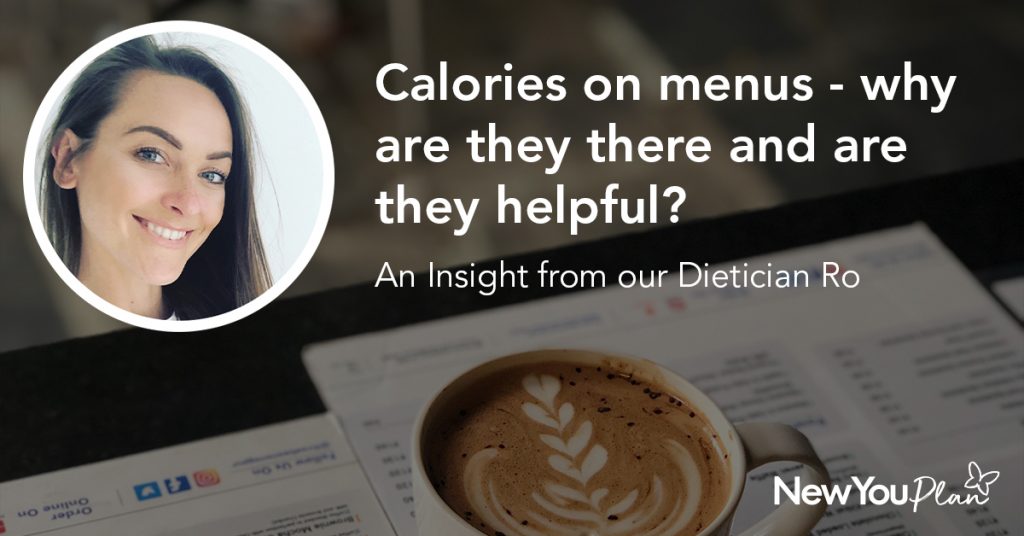BLOGS FOR MOVING

Calories on menus – Why are they there and are they helpful?
Voluntary calorie labelling on menus came into place in 2011 in the UK, which over 40 businesses have taken part in. However, from 6 April 2022, it will be mandatory by law for some businesses to display the calories in the food and drink they sell. This applies to businesses that have more than 250 employees and sell non-prepacked food or drink that someone might consume straight away. This includes restaurants, cafes, fast food places but also contract caterers, trains, ferries and planes that work within the UK.
This initiative is part of a plan to tackle obesity, as an increase in eating out has been implicated as a possible contributor. The aim of menu labelling is to help us make informed, healthier decisions about what we eat and drink. It’s also hoped that it will encourage businesses to reformulate the food and drink they offer and provide lower-calorie options as well.
What’s the evidence?
On the whole, evidence to date is unclear as to how effective calorie labelling is at changing people’s food choices.
Evidence suggests that menu labelling doesn’t significantly change the calorie content of what people buy (1,2,3). Research from New York, where labelling has been mandatory since 2008 suggests that while at first, it increases people’s awareness of calorie content, this significantly declines over time. Also, this awareness had no impact on the calories or other nutrients purchased (4).
Global research has also found mixed results concerning the reformulation of foods, and the evidence suggests that most of the reformulation changes that did happen were to starters and side dishes (5). However, many new items that were added to the menu after mandatory labelling were more likely to be lower in calories than items that were offered regularly.
One UK study conducted after voluntary menu labelling came into place found that items from restaurants that provided labelling had 45% less fat and 60% less salt (6). This analysis only included 42 restaurants so it’s hard to say if this will be the case for all food outlets that will be mandated to include calorie labelling on menus rather than volunteering to do so, however it is a positive outcome.

What difference could it make to you?
Despite the evidence above that calorie labelling may not always change consumer behaviour, it could empower you to make more informed choices to improve your health or support your weight management journey.
Consuming and buying food not prepared by yourself can be such an unknown. When weight loss or weight management is your aim, having an idea of the number of calories you are consuming per day can be a powerful tool to help you reach your goals. Often the calories in meals prepared outside the home can be a lot higher than similar options cooked within the home and having no idea the calorie content of a meal can be unhelpful and cause anxiety when they are your only option. Mandatory labelling will mean that you should have a better idea of how foods consumed outside of the home can fit with your goals.
As evidenced by the UK study above, menu labelling could also make more lower-calorie, -salt or -saturated fat options available to you. Thus making eating out, socialising and grabbing something quick when you’ve forgotten to bring lunch to work much easier and stress-free. Not only do you have a much better idea of the calories you’re eating, but you might also be more likely to eat something that meets your needs.
On the other hand, while providing calorie information on menus may be useful for some people, for others it may overemphasise the importance of calories. If this is you, it’s important to remember that food is so much more than just the energy it provides! Consuming a range of different foods and nutrients is so important for maintaining our health. There is also the enjoyment we get from food, and the cultural and social experiences we often get from eating out. Knowing the amount of calories in certain foods can be useful however it doesn’t mean we always have to choose the option with the lowest amount in every scenario.
References:
- Long MW, Tobias DK, Cradock AL, Batchelder H, Gortmaker SL. Systematic review and meta-analysis of the impact of restaurant menu calorie labeling. Am J Public Health. 2015;105(5):e11-e24. doi:10.2105/AJPH.2015.302570
- Bleich SN, Economos CD, Spiker ML, et al. A Systematic Review of Calorie Labeling and Modified Calorie Labeling Interventions: Impact on Consumer and Restaurant Behavior. Obesity (Silver Spring). 2017;25(12):2018-2044. doi:10.1002/oby.21940
- Cantor, J., Torres, A., Abrams, C., & Elbel, B. (2015). Five years later: awareness of New York City’s calorie labels declined, with no changes in calories purchased. Health Affairs, 34(11), 1893-1900.
- Cantu-Jungles TM, McCormack LA, Slaven JE, Slebodnik M, Eicher-Miller HA. A Meta-Analysis to Determine the Impact of Restaurant Menu Labeling on Calories and Nutrients (Ordered or Consumed) in U.S. Adults. Nutrients. 2017; 9(10):1088. https://doi.org/10.3390/nu9101088
- Rincón-Gallardo P S, Zhou M, Da Silva Gomes F, et al. Effects of Menu Labeling Policies on Transnational Restaurant Chains to Promote a Healthy Diet: A Scoping Review to Inform Policy and Research. Nutrients. 2020;12(6):1544. Published 2020 May 26. doi:10.3390/nu12061544
Theis, D. R., & Adams, J. (2019). Differences in energy and nutritional content of menu items served by popular UK chain restaurants with versus without voluntary menu labelling: A cross-sectional study. PloS one, 14(10), e0222773.
Luke Marshall
0





